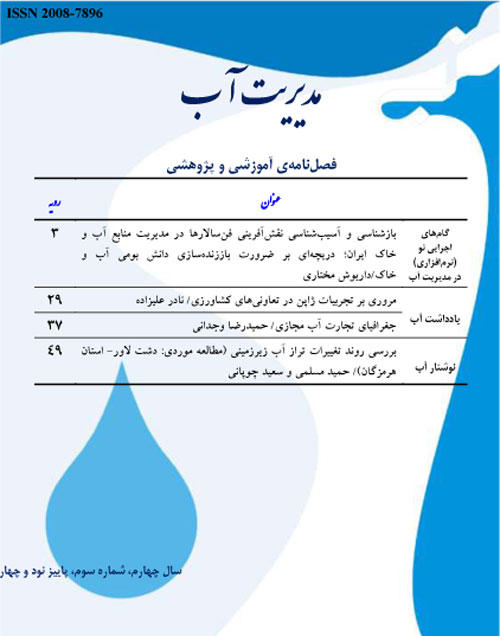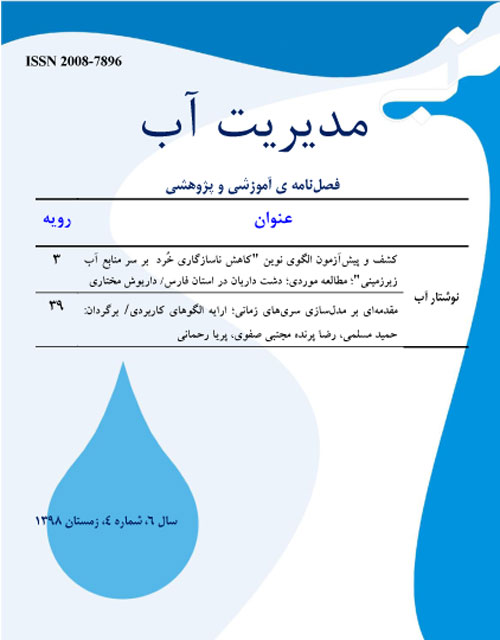فهرست مطالب

نشریه مدیریت آب
سال چهارم شماره 3 (پیاپی 10، پاییز 1394)
- بهای روی جلد: 120,000ريال
- تاریخ انتشار: 1394/09/23
- تعداد عناوین: 5
-
صفحه 1
- گام های اجرایی نو (نرم افزاری) در مدیریت آب
- یادداشت آب
-
صفحه 37
- نوشتار آب
-
بررسی روند تغییرات تراز آب زیرزمینی / مطالعه موردی: دشت لاور- استان هرمزگانصفحه 49
-
Page 3With the establishment of the Ministry of Agriculture and Trade in 1899, the Agricultural Bank in 1933 and the Irrigation Development Company in 1943, the power of technocrats increased in the country's water and land management. In parallel, educational and research institutions in the field of water and soil were formed and subsequently began to educate graduates of water and agriculture, especially technical engineering. Subsequently, the country's water and land management was limited to technical engineering aspect, only. It was as a "highly powerful technocrats" was tied with a "highly inefficient bureaucracy" and so, the countries's mother resources have been destroyed, and this event has put Iran in the final rank of 152 (or rank 132th) in the world in terms of mother resource management. In this paper, it has been attempted the role of technocrats in country's water and soil management in a transient way. Then, have been give suitable pathology for applying one of the most prominent human capital of the country. As far as the need to look again at the layout of the country's water and soil executive agencies is a barrier between government and farmers to represent the government and the farmers community. Thus! A way to regain consciousness ethnic knowledge of soil and water will be opened up in the country. This is a fundamental solution for achieving good water governance in the country.Keywords: technocrats, Water, soil resources, Iran, Management, Indigenous knowledge
-
Page 29With Considering that the development of cooperatives in the agricultural sector has been seen as one of the general policies of the system and in the fifth development program of the country. Assisting from the knowledge, experience, learning and achievements of different countries in this field can be a great help to take on the basic steps to be taken on this path. This article discusses the experience of Japan in agricultural cooperatives. Japan's cooperative agriculture companies, although they have more than 100 years of experience, But the cooperative movement in the agricultural sector of Japan has grown affectedly since the implementation of the Land Reform Program, which took place after World War II. Considering the characteristics of agricultural cooperatives in Japan, it can be said that multi-purpose agricultural cooperatives (JA) and cooperative land improvement areas (LID) play the most role in this country. For reason of similarity of multi-purpose agricultural cooperatives with rural cooperative and land reform area cooperative with rural production cooperatives in Iran, these two templates have been investigated.Keywords: Cooperative, Japan, Multi-purpose Agricultural Cooperatives, land reform area cooperative
-
Page 37Virtual water is the amount of water consumed in the process of producing a commodity that is traded abroad. Virtual water Trading Geography is determined based on the calculation of the amount of water consumed by the goods being imported or exported. Although virtual water trade can be calculated for all agricultural and nonagricultural commodities, But the virtual water water of agricultural products is paying more attention. Many countries preserve their precious water by importing some products that consumed more water and produce products that can be produced with less water inside the country. Although in level global, virtual water trade in agricultural products has led to an increase in water efficiency on the earth and has resulted in savings. But some countries, with their additional exploitation of their water resources, produce products to the global marketplace. Studies and research on the "virtual water" and "water footprint" and its trade have so far been carried out more internationally and across countries, but this can also be very important in the federal regions.Keywords: virtual water, geography, trade, sustainable water development
-
Page 49Investigation of trend of underground water level changes in Lavar plain in Hormozgan province. The purpose of this study is to investigate the quantity of groundwater in the Lavar plain of Fin section in Bandar Abbas region, and identify and assess the consequences of additional extraction of groundwater and provide useful strategies for progressive problems. In order to do this research, 6 observation wells were studied in the period of 20 years (1964-1394). For this purpose all the meteorological, hydrological, hydrogeological, geological and geological data of the area have been collected and analyzed. After that, overdrawing, drainage and drainage losses in the plain groundwater area were calculated. Based on the calculations, the groundwater level of the plain has fallen 28.4 m in the 20-year period, which is an average of 21 centimeters a year on average. Therefore, if no serious and effective action is taken in this area, this plain will face not only environmental degradation but also economic and social problems in the future. To prevent the destruction of the aquifer, which is a vital issue, precise control over the removal of groundwater resources, preventing the development of agricultural landslides, artificial nutrition of groundwater table, promoting culture of conservation and greening of crops is recommended.Keywords: Hormozgan Province, Groundwater, Water Loss, Lavar Plain Fin


